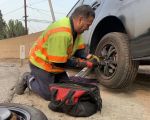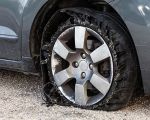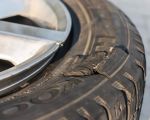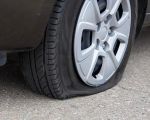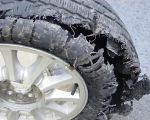What to Do If Your Tire Is Damaged Beyond Repair
1. Understanding Tire Damage: What Is Considered Beyond Repair?
As a car owner, I’ve had my share of flat tires and punctures, but there are times when tire damage is so severe that a simple fix just won't do. A tire can be damaged beyond repair for a variety of reasons, and it’s important to understand what qualifies as beyond repair to avoid putting yourself or others in danger on the road.
One of the most common types of damage that cannot be repaired is a sidewall puncture. Unlike the tread of a tire, which can be patched, the sidewall is too flexible and thin to hold a repair. If your tire has a tear or hole in the sidewall, it’s usually unsafe to repair it, as this part of the tire takes on much of the vehicle’s weight and stress.
Other types of damage that may render a tire irreparable include:
- Multiple punctures: If a tire has multiple punctures close to each other, it can compromise the integrity of the tire, making it unsafe to repair.
- Severe tread wear: If the tread has worn down to the point where the tire cannot grip the road properly, it’s better to replace it.
- Severe impacts or bulging: If a tire has suffered a blowout, has visible bulges, or you feel vibrations when driving, the tire has likely been damaged beyond repair.
In these cases, replacing the tire is often the best and safest option. Understanding what constitutes irreparable damage can help you make the right decision when faced with a damaged tire.
2. The First Steps After Your Tire Is Damaged Beyond Repair
If you find yourself in a situation where your tire is damaged beyond repair, it’s crucial to stay calm and follow the right steps to ensure your safety and avoid further damage to your vehicle. Here’s what I do when faced with this situation:
- Pull over safely: As soon as you notice that your tire is damaged beyond repair, find a safe location to pull over. This could be a parking lot, the side of the road, or a designated rest area. Make sure you’re away from traffic, especially if you're on the highway.
- Activate your hazard lights: Turn on your hazard lights to alert other drivers that you're experiencing an issue and are temporarily stopped.
- Check the damage: Take a quick look at the damaged tire. If you see that the damage is beyond repair (sidewall tear, severe bulging, or multiple punctures), it’s time to call for help.
Once you’ve assessed the damage and ensured you’re in a safe location, your next step is to call for roadside assistance or a towing service if needed. At this point, trying to continue driving with a damaged tire could lead to further issues, such as damage to your vehicle’s alignment or suspension.
3. What to Do If You Have a Spare Tire
In some cases, you may be lucky enough to have a spare tire in your car. If the damage isn’t too severe and you feel confident in your ability to change the tire, having a spare can make the situation much easier. Here’s how I go about using a spare tire:
- Locate the spare tire: The first thing to do is find your spare tire. In most vehicles, it’s located in the trunk or underneath the vehicle.
- Use the jack and tools: Ensure that you have all the necessary tools: a jack, a lug wrench, and the spare tire. Once you have them, follow the instructions to safely jack up the car.
- Remove the damaged tire: Use the lug wrench to loosen the lug nuts on the damaged tire before lifting the car with the jack. Once the car is raised, remove the lug nuts completely, and then take off the damaged tire.
- Install the spare: Carefully place the spare tire onto the wheel hub and screw the lug nuts back on. Tighten them securely before lowering the car back to the ground.
It’s important to note that a spare tire is typically a temporary solution. Most spare tires are “donut” tires, meaning they’re smaller and not meant for long-distance driving. Once you’ve swapped out the damaged tire with the spare, head to a tire shop or mechanic to get a permanent replacement as soon as possible.
4. Calling a Towing Service for Tire Replacement
Not everyone feels comfortable or confident in changing a tire on the side of the road. In my case, I’ve had to rely on towing services a few times, especially when I was stranded in an unfamiliar area or couldn’t get the spare tire on properly. In such situations, calling for professional help is a smart and safe decision.
Here’s how I go about calling a towing service when my tire is damaged beyond repair:
- Contacting roadside assistance: If you have a roadside assistance package through your insurance or a third-party provider, it’s a good idea to call them for immediate help. Many services include tire replacement as part of their offering, and they’ll be able to send a professional to assist you.
- Using a towing company: If roadside assistance isn’t an option, or if you simply need a tow to a nearby repair shop, calling a towing service is your next best option. I’ve used companies like Rescue & Towing in the past, and they’ve always provided fast and reliable service. Their professional tow truck drivers not only tow your vehicle but can also take care of tire-related issues on the spot.
When calling a towing service, be sure to provide them with the exact location and details about the damage. The more information you provide, the quicker they can assess the situation and send the appropriate help.
5. When to Replace Your Damaged Tire
Once your damaged tire is removed and a new one is needed, it’s time to think about replacement. Over the years, I’ve learned that not all tires are created equal, and choosing the right one is crucial for vehicle safety and performance.
- Matching your tires: If you’re replacing just one tire, make sure it matches the others in terms of size, brand, and tread pattern. This helps maintain proper handling and performance.
- Choosing quality over cost: I’ve always preferred to invest in high-quality tires rather than the cheapest option. A reliable tire can improve safety, fuel efficiency, and the overall driving experience. Look for reputable brands and consider the type of driving you do.
- Rotation and alignment: After replacing a damaged tire, it’s a good idea to have the remaining tires rotated and the car’s alignment checked. This ensures even tire wear and optimal handling.
Replacing a damaged tire with the right one will improve your vehicle's safety and performance. Whether you’re replacing a tire because of irreparable damage or just regular maintenance, it’s always important to prioritize quality and proper fit.
6. Explore Towing and Tire Replacement Services with Rescue & Towing
If you find yourself dealing with a damaged tire and need assistance, I highly recommend reaching out to Rescue & Towing. They offer a comprehensive range of services, including tire replacement, roadside assistance, and reliable towing. Their team of professionals can help you get back on the road quickly and safely, no matter where you are.
Don’t let a damaged tire ruin your day—get the help you need with Rescue & Towing’s expert services. Visit Rescue & Towing for more information and to sign up for their affordable packages.
















